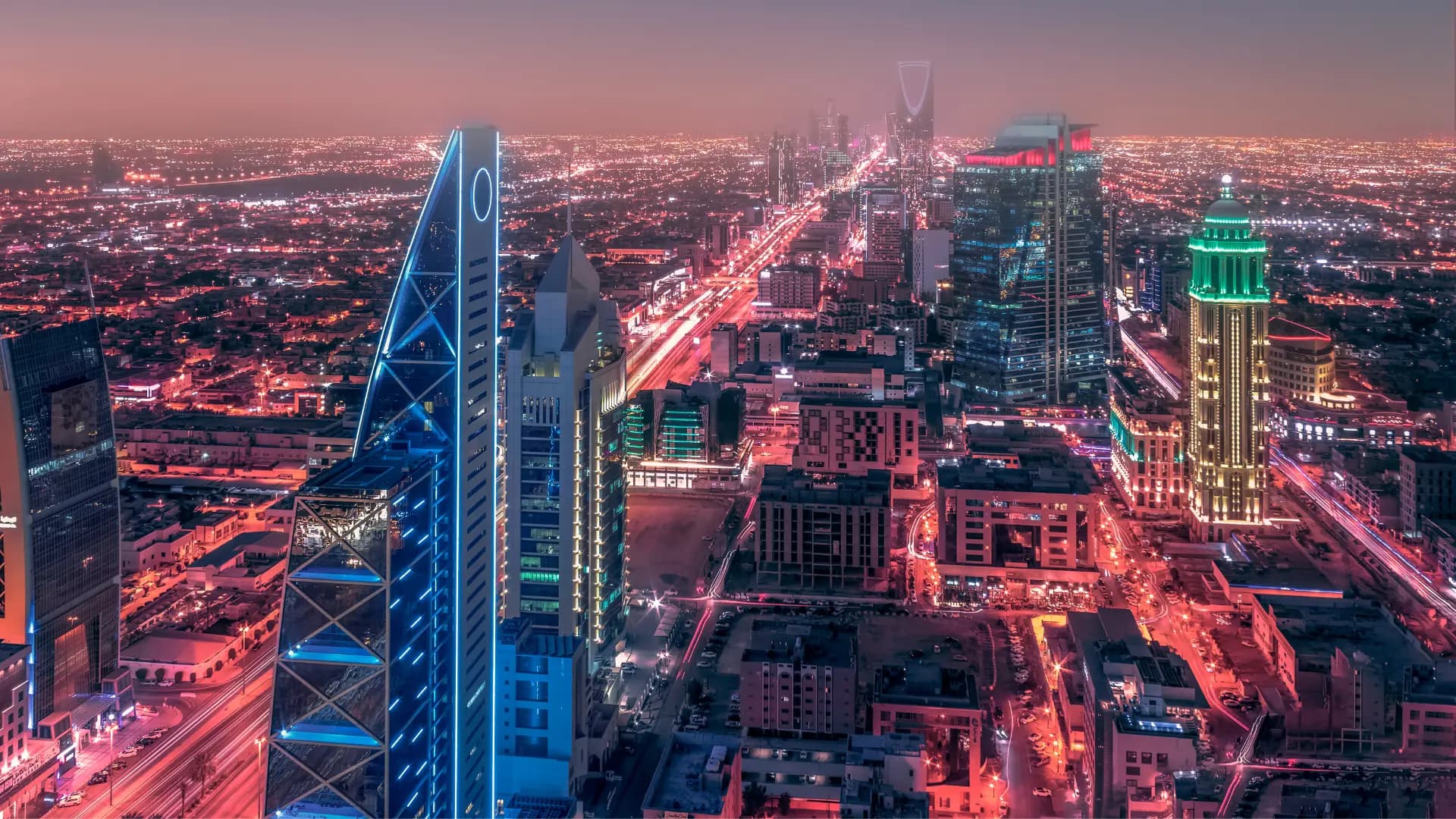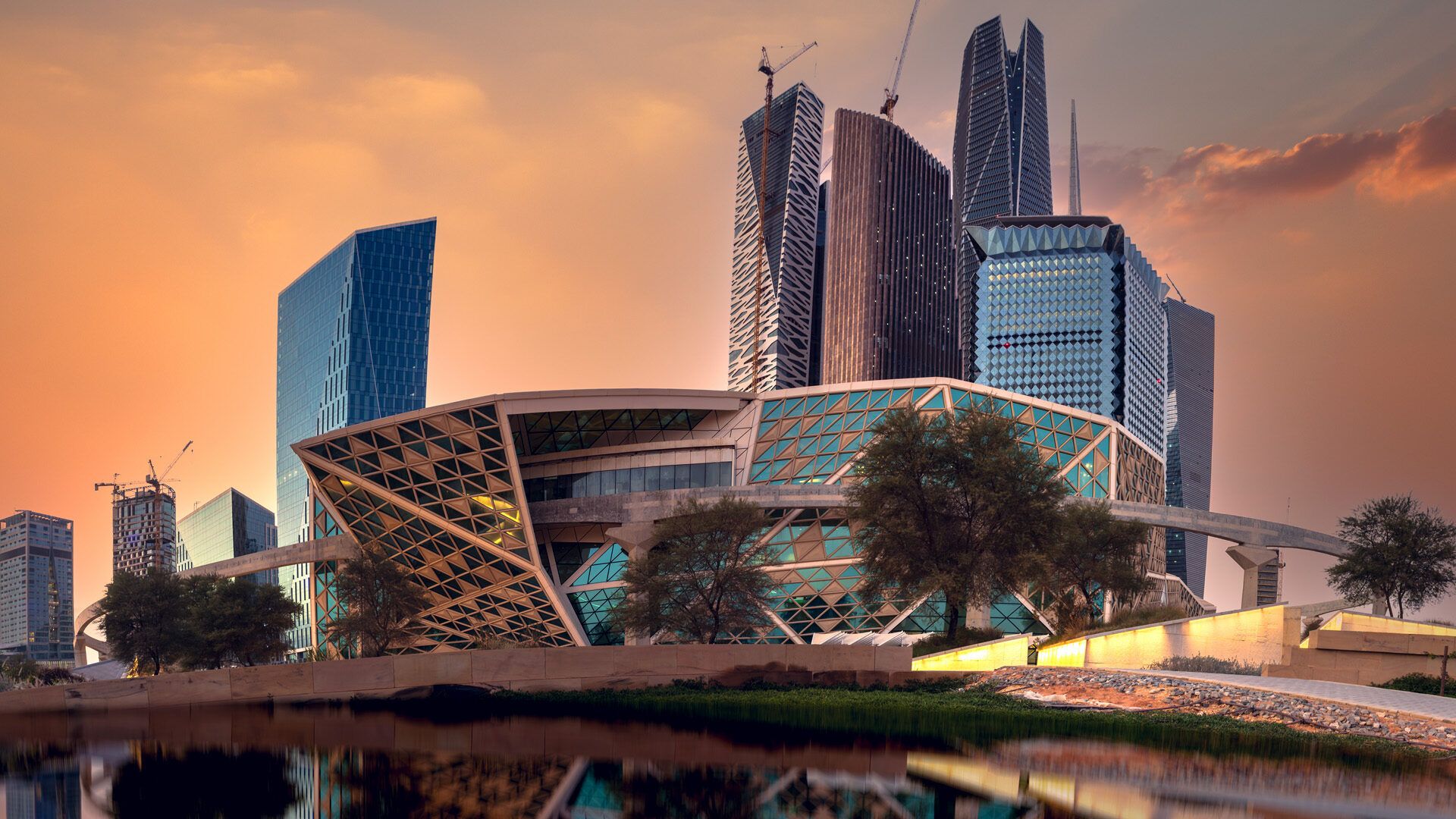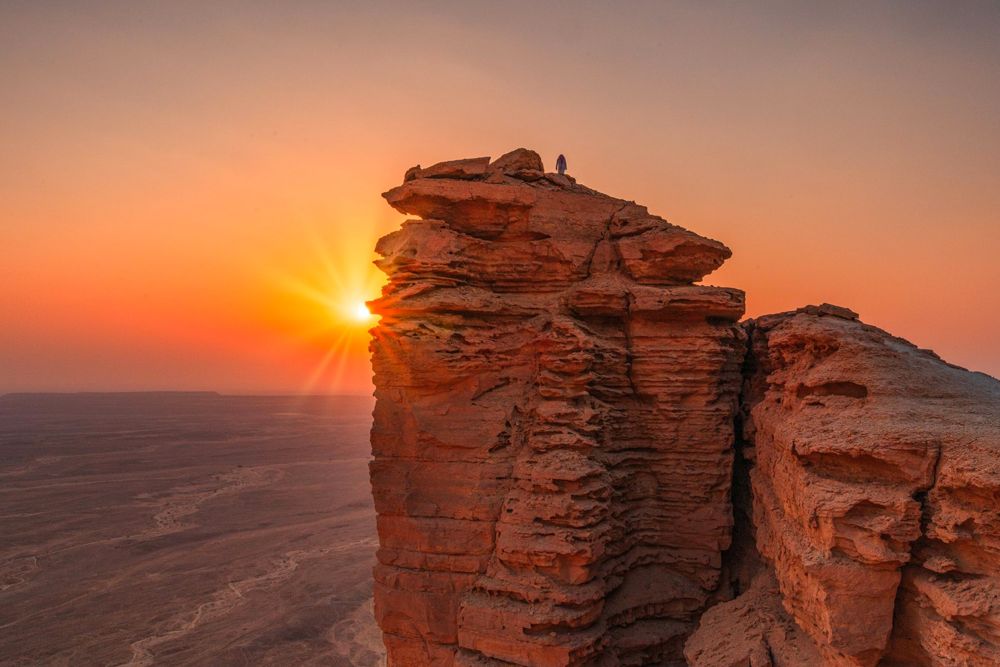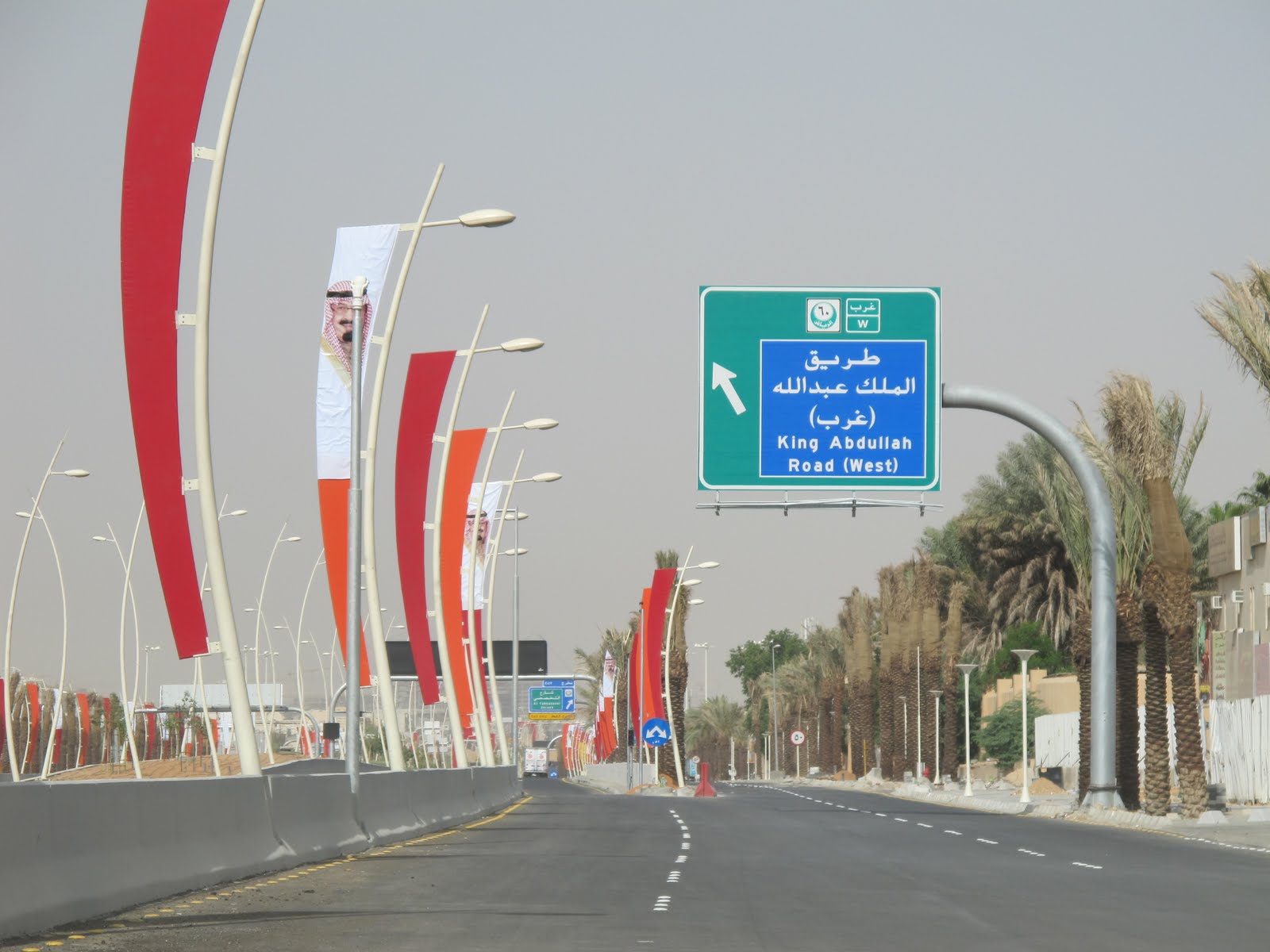
Riyadh is the capital and the most populous city of Saudi Arabia. It is also the capital of Riyadh Province and belongs to the historical regions of Nejd and Al-Yamama. It is in the center of the Arabian Peninsula on a large plateau and is home to 7,821,000 metropolitan population in 2024.
The city is divided into 15 municipal districts, managed by Riyadh Municipality headed by the mayor of Riyadh, and the Riyadh Development Authority, chaired by the governor of Riyadh Province, Faisal bin Bandar Al Saud. The current mayor of Riyadh is Ibrahim Mohammed Al Sultan. He was appointed mayor in 2015.
During the Pre-Islamic era the city at the site was called Hajr and was reportedly founded by the tribe of Banu Hanifa. Hajr served as the capital of the province of Al Yamamah, whose governors were responsible for most of central and eastern Arabia during the Umayyad and Abbasid eras. Al-Yamamah broke away from the Abbasid Empire in 866 and the area fell under the rule of the Ukhaydhirites, who moved the capital from Hajr to nearby Al Kharj.
The city then went into a long period of decline. In the 14th century, North African traveller Ibn Battuta wrote of his visit to Hajr, describing it as "the main city of Al-Yamamah, and its name is Hajr". Ibn Battuta goes on to describe it as a city of canals and trees with most of its inhabitants belonging to Bani Hanifa, and reports that he continued on with their leader to Mecca to perform the Hajj.
Riyadh is the capital of Riyadh Province, the center of Riyadh Governorate. It is the largest and most populous city in Saudi Arabia with a population of more than 7.8 million people as of 2024.
Riyadh is the capital of Saudi Arabia and was formerly known as Hajr al-Yamamah. The city receives 5 million visitors per year making it the forty-ninth most visited city in the world.
Riyadh is the political and administrative center of Saudi Arabia as the Consultative Assembly, the Council of Ministers, the King and the Supreme Judicial Council of Saudi Arabia are all domiciled in Riyadh.
Riyadh has been designated as a global city and holds great economic significance, as it hosts the headquarters of many banks, major companies and over 112 foreign embassies.
King Abdullah Financial District, one of the world’s largest financial districts, the Faisaliyah Center and the Kingdom Center are all located in Riyadh.

The city of Riyadh as at April 2022 was home to one sixth of the population of the Kingdom of Saudi Arabia at about 7.82 million. Experts have pointed out that about 40% of the population is made up of non-Saudis while Saudis make up 60% of the city’s population. The two biggest groups of non-Saudis living in Riyadh are Indians at 13.7% and Pakistanis at 12.4%.
The Kingdom Centre, a 41-storey building that soars 302.3 meters or 991.79 feet above the city’s skyline is located in Riyadh. It was the tallest building in the Kingdom of Saudi Arabia when it was opened in 2002.
The Riyadh University which now goes by the name of King Saud University was founded in 1957 by King Saud bin Abdulaziz. The university, which is home to some impressive buildings, for instance, the King Salman Central library, is the oldest university in Saudi Arabia.
The King Salman Central library is a seven-floor building with more than 4,000 seats and has a vast collection of books, periodicals, manuscripts and government publications. The library also has a vast collection of academic theses, and dissertations, press clippings, audio-visual and electronic media.
Riyadh is classified as a global city and carries the nickname of the money capital of the Middle East as it plays an important role in the economic system of the world.
Riyadh is the region’s fourth-most global city of the Gulf Cooperation Council. There are over 110 embassies, consulates and headquarters of several international and regional organisations including the Gulf Cooperation Council located in Riyadh.
As early as the third century AD, Banu Hanifa settled in the area of the present-day Riyadh and gave it the name of Hajr in the then province of Al Yamaah. Until 1823, Riyadh was not the capital city of the country. The vast oil reserves were discovered in 1938 near the Persian Gulf and Saudi Arabia become a very wealthy country since then. The country was the largest oil exporter in the world by 1976.
The Masmak Fort in ad-Dirah, a district in southern Riyadh is a clay and mudbrick fort. The fort was constructed for prince Abdurrahman ibn Sulaiman AlDabaan at the order of the Emirate of Jabal Shammar.
One of Saudi Arabia’s most popular tourist destinations is Jebel Fihrayn, also known as the Edge of the World. Atop its 300-meter-high cliffs, the Edge of the World promises uninterrupted view of the horizon overlooking the surrounding plain.

In the Pre-Islamic era, the city known as Hajr was founded by the Banu Hanifa tribe and served as the capital of the Al-Yamamah province during the Umayyad and Abbasid eras. In the 14th century, it went into decline, breaking up into separate settlements. The name "Riyadh," meaning "gardens," first appeared in the 17th century. In 1737, Deham ibn Dawwas took control of Riyadh, encircling oasis towns and establishing it as a single city.
In 1750, an alliance between Muhammad ibn Abd al-Wahhab and Muhammad ibn Saud led to the conquest of the region, with Riyadh capitulating to the Saudis in 1774. The First Saudi State was established, with Diriyah as its capital. However, it was later destroyed by forces from Egypt acting on behalf of the Ottoman Empire in 1818. Turki bin Abdullah bin Muhammad became the first Amir of the Second Saudi State, choosing Riyadh as the capital in 1823. The Second Saudi State fell in 1891 to the rival Al Rashid clan, leading to a period of decline.
Abdul Aziz, son of Abdul Rahman bin Faisal al-Saud, reclaimed Najd in 1902, consolidating his rule and expanding his kingdom to form Saudi Arabia in 1932, with Riyadh as the capital. The city underwent modernisation from the 1940s onwards, with the development of new settlements and neighborhoods. In 1983, King Khalid International Airport was opened. Riyadh has become a major administrative and commercial hub, marked by significant high-rise development, including the King Abdullah Financial District. Recent efforts include heritage building restoration initiated in 2020 by Crown Prince Mohammed bin Salman.
The city of Riyadh is located in the Riyadh province, which is further divided into governorates. The chief administrator of the city is its mayor, who is appointed by the king of Saudi Arabia. The major functions of the city government are similar to those of many other metropolitan cities.
The High Commission for the Development of Riyadh sets forth policies for the city’s development formulated by its executive branch, the Arriyadh Development Authority (ADA). The ADA, which is responsible for the socioeconomic, cultural, and environmental development of the city, devises plans and procedures to improve the standard of services and facilities provided for city residents. The ADA does not rely upon the national budget for its funding.
Riyadh is undergoing a profound transformation, positioning itself as the prime destination for businesses and aspiring to claim the title of the region's top hub for finance and tourism. Spearheading this change is Crown Prince Mohammed bin Salman's Vision 2030, a visionary blueprint aimed at job creation and economic diversification in response to the country's youthful demographic profile.
In a bid to incentivise companies, Saudi Arabia has introduced the "Regional Headquarters Attraction Program", giving businesses until the beginning of 2024 to relocate their regional headquarters to Riyadh.
As part of Vision 2030, Saudi Arabia's Public Investment Fund plays a pivotal role in generating jobs and fostering non-oil economic growth through mega-projects. The government's initiative aims to inject $18 billion into the local economy and create 30,000 new jobs over the next decade. Despite fluctuations in foreign direct investment figures, the government is committed to providing clear answers and creating an attractive business environment. The city is preparing itself to host the World Fair Expo in 2030.
As the country’s capital, Riyadh hosts numerous government ministries and public services headquarters, making the public sector the city’s largest employer. The government employs more than one-third of the city’s workforce and is the source of approximately half of Riyadh’s total production of goods and services. Saudis account for more than nine-tenths of total government employees. In the private sector, more than two-fifths of the workforce is employed in services, about one-fourth in construction, more than one-fifth in trade, and about one-tenth in industry.
Riyadh is an important financial, business, and manufacturing centre. A number of banks are headquartered in the city, including Saudi Arabia’s central bank and several national banks. Numerous private companies are also located there, and every publicly quoted company is compelled by law to have an office in the city. About one-third of the country’s factories are located in Riyadh, producing machinery, equipment, metallurgical goods, chemicals, construction materials, food, textiles, furniture, and publications.
The government of Riyadh is introducing an array of ambitious infrastructure projects. Among these, the Bridge Project at the Intersection of King Abdullah Road with Prince Turki Bin Abdulaziz I Road is a notable venture aimed at enhancing transportation efficiency. Meanwhile, the Qasr Al-Hukm District Development Project is contributing to the city's cultural and historical landscape.

The city is also envisioning new developments to meet future needs. The Abu Bakr Al-Siddiq Road Development Project addresses the city's evolving infrastructure requirements. Furthermore, Riyadh boasts over 30 mega projects, each playing a distinctive role in shaping the city's future. Notable among these are Qiddiya, an entertainment, sports, and cultural destination; Diriyah, a historical and cultural epicenter; green Riyadh, emphasising environmental sustainability; King Salman Park, a vast green space for recreation; and a comprehensive metro system, designed to enhance public transportation and connectivity.
The IT market in Saudi Arabia holds substantial significance, boasting a valuation exceeding $40.9 billion, making it the largest in the Middle East and North Africa region. Anticipated to grow at a Compound Annual Growth Rate (CAGR) of 7.48% between 2022 and 2027, the hardware segment takes the lead.
The Saudi Arabian government's proactive approach to digital transformation is evident through the implementation of the National Transformation Program (NTP), initiated in 2016. This comprehensive program aims to digitise various sectors of the economy, spanning manufacturing, government, healthcare, and the BFSI (Banking, Financial Services, and Insurance) industry. Aligned with the broader Vision 2030 program, the NTP sets forth strategies for economic diversification and the creation of new employment opportunities.
As IT adoption continues to surge in Saudi Arabia, propelled by the execution of the NTP, Riyadh emerges as a focal point for digital transformation across diverse economic sectors. One notable trend is the increasing adoption of e-governance.
At Saudi Arabia ABC, we aim to take you on a transformative journey through the magic of immersive experiences. Whether you are an adventurous traveller or a curious local seeking hidden gems, our platform offers a rich tapestry of content designed to cap